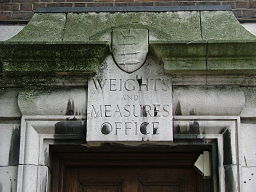


A lot of people like to talk about how the U.S.A. is the only country not to go metric, and that's not entirely true. While much of Europe is mostly metric I want to talk about some trends I've noticed about weights, measurements and temperatures in Europe and Canada. Another thing to address, just to say this up front, is that metric units are not always SI units.
Officially, the Canadian government uses kilograms for people. However I've never met a Canadian person who told me their weight that way. Canada still seem to use pounds for humans, and it's not uncommon to find food measured in ounces, rather than grams. The UK still measures people in pounds and stone. One stone is 14 pounds. Wikipedia will tell you the use of the measurement was outlawed, however this can't be controlled to well as even recent TV programs refer to people with Stone and pounds. Interestingly enough ounces and grams seem to be used side-by-side for food and other goods, depending what's being weighed. It seems that grams and kilograms are the standard, except with people. One stone is also just over 6 kilograms, for reference.
Measurements seem to be one of the things that have changed. Sort of. In the UK, depending where you are, it does not seem to be uncommon for people to measure human height in feet and inches still, based on accounts. However, based on the media exported by the BBC it seems that that's no longer fashionable. For distance the UK still seems to use feet and inches for measurements around the home, for "short" distances but meters and kilometers for "long" distance. Interestingly enough, I've seen UK maps measure in 10ths of kilometers instead of just meters. Go figure. It does seem that feet and inches have fallen out of favor for distance probably about 15 or 20 years ago, but there's still people around using them occasionally. The UK still has an officially defined pound, just under 500 grams, however outside of humans I've never heard this used. Canadians I've spoken with have used feet and inches for human height, as well as centimeters. Some seem more comfortable with one opposed to the other. It does not appear to be related to age in this case.
As for temperature, the US still uses Fahrenheit and all other countries still use Celsius. It seems Canada still cooks in the old imperial units, including degrees Fahrenheit, but people do not discuss the weather or body temperature in Fahrenheit. Furthermore appliances are starting to feature both units and metric cooking measurements are widely available so this may be changing.
My purpose for explaining all this is twofold. Firstly, the metric conversions began in the 1960's and are just now becoming normal with "the younger generation" for the most part. Canada in particular still often lists both units and it's not uncommon to see both in the UK still. It's not as though someone flipped a metric switch and everyone suddenly thought in meters, grams and Celsius. I also feel that if the US is still going to try and become more standard the real help would be adopting Celsius. People actually talk about the weather and climate is one thing that does affect the world globally. I feel that the US could quite happily keep our other old measurements, even if for fluids we kind of mix ounces and liters for beverages.
Image: Sign of the former Weights and Measures office, Seven Sisters Road, Middlesex, England. (Notice the modern security camera in the door frame). photographed by Nico Hogg. Distributed under a Free content licence, Creative Commons Attribution 2.0 Generic license.